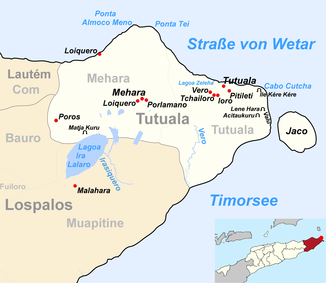Irasiquero
| Irasiquero | ||
|
The Irasiquero on a map of the Tutuala Administrative Office |
||
| Data | ||
| location | East Timor , Lospalos Administrative Office | |
| River system | Irasiquero | |
| origin |
Ira Lalaro 8 ° 27 ′ 39 ″ S , 127 ° 9 ′ 49 ″ E |
|
| Source height | 318 m | |
| muzzle |
Mainina Hole , ends in a Ponor Coordinates: 8 ° 28 ′ 25 ″ S , 127 ° 10 ′ 50 ″ E 8 ° 28 ′ 25 ″ S , 127 ° 10 ′ 50 ″ E
|
|
| Flowing lakes | Ira Lalaro | |
|
Water lilies on the Irasiquero, 500 meters from Ira Lalaro near Malahara |
||
The Irasiquero ( Irasiquiru , Ira Siquero ) is an East Timorese river in the Suco Muapitine ( administrative office Lospalos , Lautém municipality ). Until 2015, the area belonged to the Suco Mehara ( Tutuala Administrative Office ).
Course and appearance

The river forms an outflow of the largest lake in East Timor, the Ira Lalaro . Since the lake loses a lot of its surface during the dry season, the origin of the river shifts a lot. Here the Irasiquero flows slowly and is dark in color. Dissolved substances from plant residues and muddy, organic sediment are responsible for this. Sometimes the water is relatively deep.
The Irasiquero continues to flow south on the Fuiloro plateau , then swings to the east and flows 3.5 km through a narrow gorge before disappearing in front of the Paitchau mountain range in the Mainina Loch , a ponor . Tests with color tracers have shown that the water reappears in three springs south of the mountains as well as in four springs near Com , on the north coast.
In the middle reaches the river is clear and is fed by groundwater. Here it flows faster and forms pools again and again. The rock floor consists of limestone, and there are also pebbles here. In some places there are tree trunks in the water, vegetation hangs over the water. Here too the river is deep. At the lower reaches of the river bed there is not only the limestone floor but also sand, pebbles and other rubble.
Flora and fauna
The Irasiquero forms a closed water system with the Ira Lalaro. There are no connections to other surface waters, so water dwellers usually cannot reach the river without human intervention.
The Craterocephalus laisapi of the genus craterocephalus is an endemic freshwater fish. It only appears in the Irasiquero, but in its entire course. The second native species Mugilogobius cavifrons is a goby . The species is known from southern Japan to Papua New Guinea . The isolated population in the Irasiquero seems to be remarkably large compared to the previously known representatives. Mugilogobius cavifrons is not yet known of any other waters of East Timor .
Four fish species were introduced by man into the Irasiquero: mosquitofish (Gambusia affinis), Panchax (Aplocheilus panchax) , African catfish (Clarias gariepinus) and Mozambique tilapia (Oreochromis mossambicus) . African predatory catfish and Mozambique cichlid also eat other fish. Nevertheless, the native species do not appear to be threatened in their existence.
The saltwater crocodile is the largest predator in the river system . This population of around 300 animals also seems to live in isolation from other crocodiles. It has grown significantly since East Timor's independence in 2002.
The great diversity of invertebrates is striking , 57 families were counted in the Ira Lalaro and Irasiquero. While you can find amphipods and woodlice in the river , there are no decapods . The reason could be the lack of an open connection to the sea. The variety of aquatic plants in the Irasiquero is also unusually large. Most of them are only found on the lower reaches of the river.
Web links
Individual evidence
- ↑ a b c d e f Helen K. Larson, Duncan Buckle, Jessica Lynas, Andrew Storey, Chris Humphrey: Additional records of freshwater fishes from Timor-Leste, with notes on the fish fauna of the unique closed Irasiquero River system
- ↑ a b c Report of Findings on the Proposed Iralalaro Hydro-ElectricPower Scheme, Timor-Leste (pdf; 3.2 MB) Haburas Foundation and the Australian Conservation Foundation. Retrieved August 9, 2013.
- ↑ Hydrotimor: Iralalaru - Iralalaru Water Flow ( Memento from January 10, 2011 in the Internet Archive ) (English)
- ↑ Craterocephalus laisapi on Fishbase.org (English)
- ↑ Mark O'Shea et al. a .: Herpetological Diversity of Timor-Leste Updates and a Review of species distributions. (PDF) In: Asian Herpetological Research. 2015, 6 (2): pp. 73-131., Accessed on July 17, 2015.


